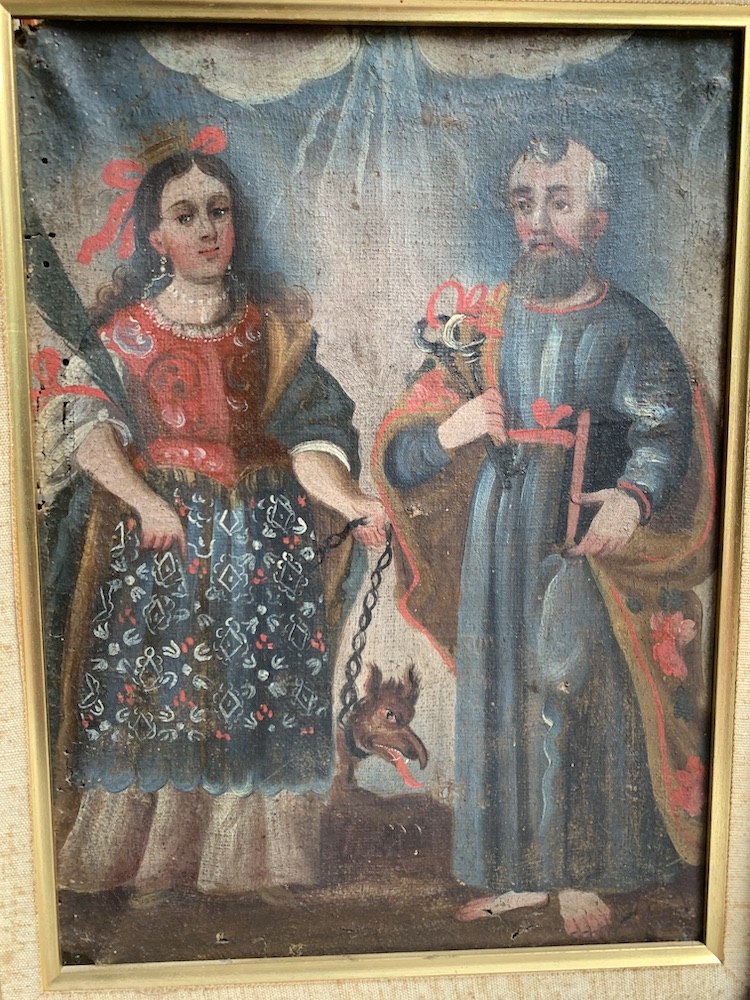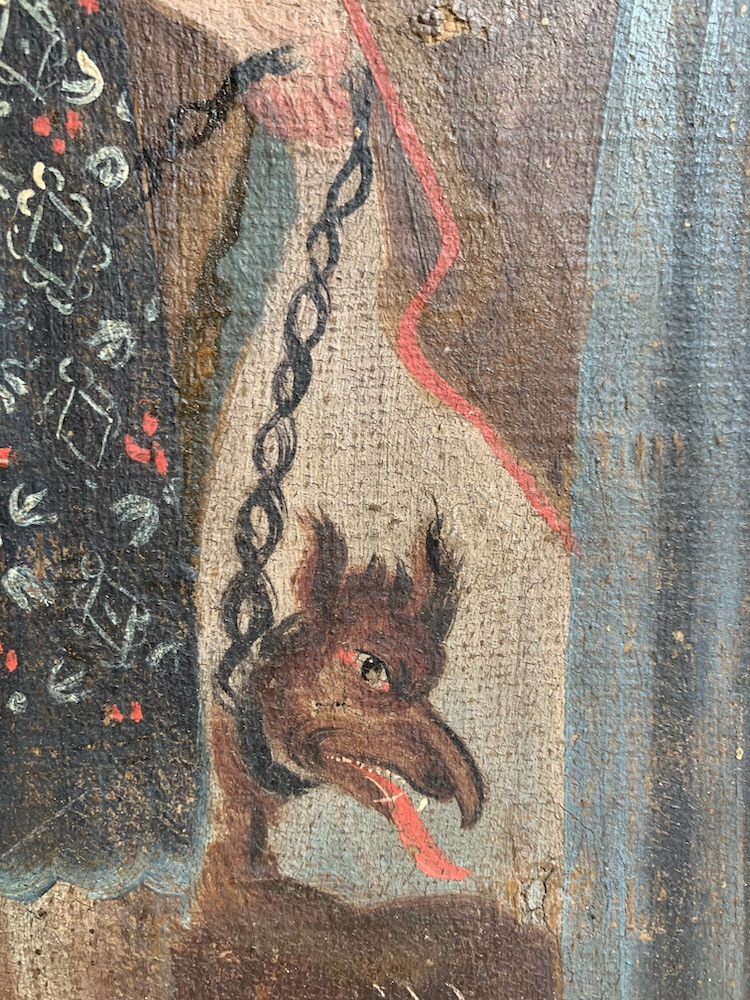Flea Market Find

JS has a small painting on canvas purchased from a booth at the Earl Warren Flea Market. Those two figures are saints, but what else can I say about the work? She writes she has never before seen such an unfortunate looking canine and had to have this work!!
First, congratulations JS; you scored. This is a late 18th/early 19th century Cuzco School painting originating from Peru. The work looks slightly naïve, as if it were painted by an artist who had little classical art training. And this is indeed the case.
Peru was “founded” (in Colonial terms) in 1543 as Spain’s Viceroyalty (until 1824), and painting was a means of Colonial evangelizing. Thus Spanish, Italian, and Flemish painters were enlisted to come to paint religious works in newly erected churches. This settlement of European artists left Europe just as a new genre of art was developing, the Mannerist School. If you remember El Greco, you can picture the mannerist style: elongation of figures, flattening of perspective, symbolism. But their training was in the bedrock of Classical European Realism called the Academic style.
In 1688, the indigenous painters who had assisted in the workshops of European painters for decades departed the Artist’s Guild, leaving the minority Spanish painters without talented aides (the indigenous and mestizo painters could not themselves attain the positions held by Europeans). These dissenting indigenous painters formed their own school – The Cuzco School – forging their own path.
These artists generally rejected the staid academic realism of their former bosses, instead painting images that seemed to tell a story in symbols and colors. Using archetypes such as the Saints, but coloring them with local features and clothing, the work dressed holy figures in rich brocades accented with gold, painted in reds, ochers, greens, blues, and white. If a scene was to be spotlit, it virtually WAS, as paintings portrayed light pictured from heaven itself. Notice the clouds opening and light spewing forth in JS’s painting.

In JS’s painting we see an older bearded figure in a pallium (papal cloak); a vested apostle who is holding the keys of heaven. The keys are the attribute of St. Peter, born Simon, but named Cephas (Peter) by Jesus. The other attribute is that book he carries; he is an author, as the New Testament contains Peter’s letters, or epistles. He is portrayed as a common-looking man – born a lowly fisherman, but raised to be the keeper of heaven’s gates. St. Peter is patron saint of sailors, fishermen, and locksmiths, and the first of all the contiguous popes.
In JS’s painting, Peter stands beside a dark featured woman with flowing hair tied with a red bow and sporting a gold crown. This is Saint Margaret of Antioch; she’s dressed in a red girdle-corset and wears an indigenous-style apron which is heavily embroidered. On a chain and subdued at her side is a timid little dragon, the attribute of St. Margaret.
Margaret is the patron saint of women in childbirth. A famed beauty, she was courted by a pagan during the Roman reign of Diocletian, then raised by a Christian nurse, as her mother died in childbirth.
She endured imprisonment rather than marry, and for her pains the devil appeared in her cell as a dragon, who ate her whole. In his belly, she made the sign of the cross – and out she popped. Margaret symbolizes victory; the triumph of the spirit over the flesh. A cult figure in medieval England from the ninth to the 16th century, she was not canonized till later because of the hard-to-swallow dragon part of her hagiography. She is one of a handful of female saints who face “the dragon.” Male saints are usually the dragon-slayers.
Another attribute is her palm frond, a symbol of martyrdom (she was executed after she burst from the dragon). The palm is a symbol of the spirit and eternal breath, as we see the palm frond ever swaying in the wind – though never changing or falling.
Both saints are a symbol of the believer who overcomes terrible trials and is justly rewarded. No coincidence that this image was painted by an indigenous Peruvian artist in the 1800s who also overcame a powerful Colonial system. Very non-European, this is painted as a sensual narrative in a heartfelt, earnest way – notice how both saints gaze directly at the viewer. This is a small devotional work; not a grand European-style altar painting, but a work for the people. The value is $800.






